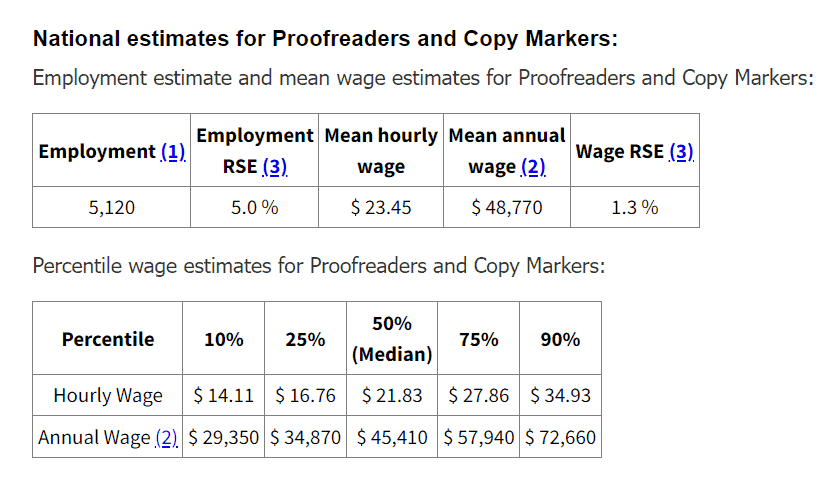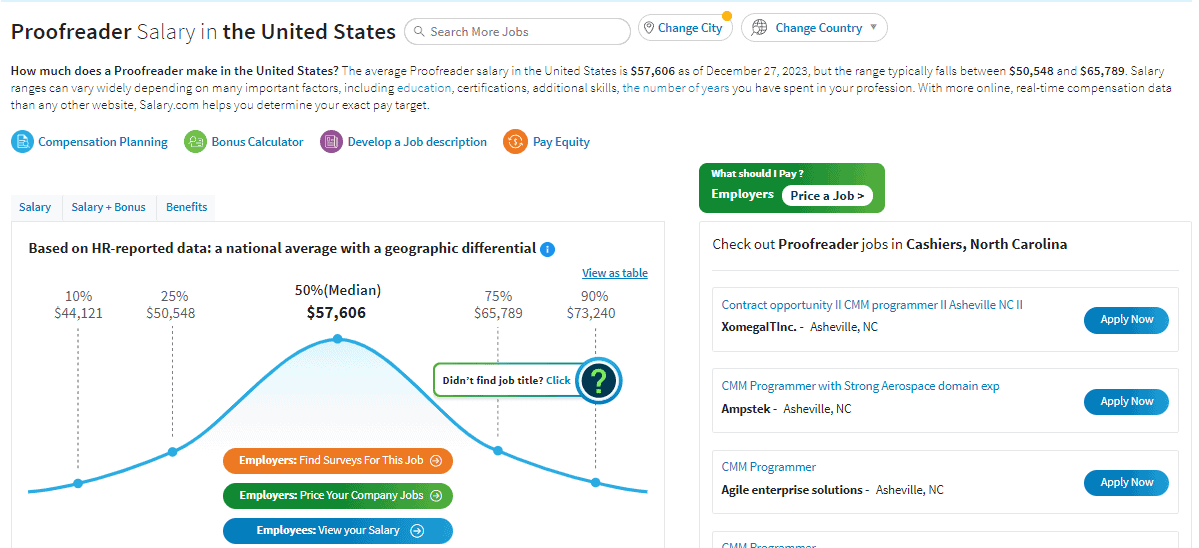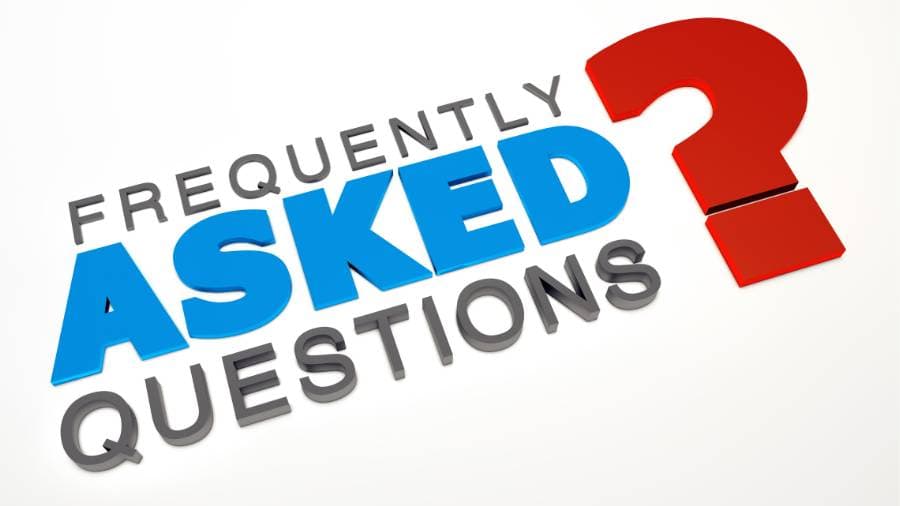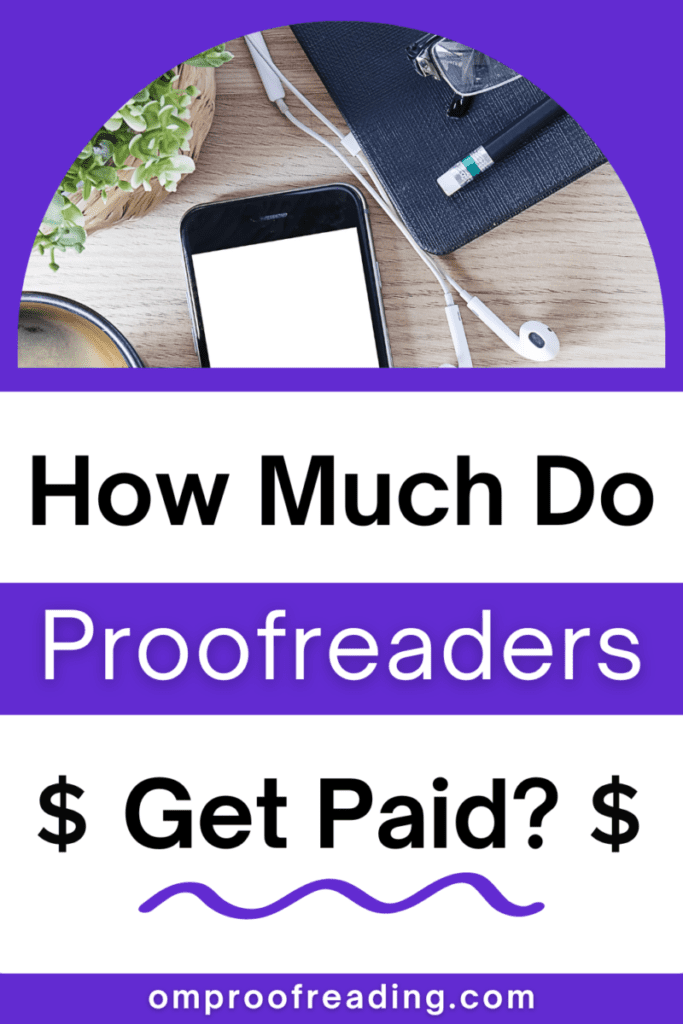This article may contain affiliate links. Please see our affiliate disclaimer in the footer menu for more information. Thank you for your support!

If you want to become a proofreader, I’m sure you’re wondering how much proofreaders get paid. When I was contemplating becoming a proofreader, this was one of the main questions on my mind.
According to the US Bureau of Labor Statistics, proofreaders get paid an average hourly wage of $23.45, or $48,770 annually. However, rates vary widely depending on proofreader-related factors (e.g., training, experience) and document-related factors (genre, complexity, etc.).
Let’s see how much proofreaders—employees and freelancers—make annually and hourly. We’ll also look at the factors that influence how much freelance proofreaders earn, including one that’s often overlooked.
How Much Do Proofreaders Get Paid? (Employees & Freelancers)
Let’s see the average earnings of proofreaders in the United States as reported by some of the most reputable sources.
All the data is from 2024, except for the US Bureau of Labor Statistics data from May 2022.
A few of the websites below update their numbers daily. You can click on the links to find the most up-to-date information.
Average Pay for Proofreaders in the United States
| Source | Yearly Pay | Hourly Pay |
|---|---|---|
| Bureau of Labor Statistics | $48,770 | $23.45 |
| SalaryExpert | $47,928 | $23.04 |
| Payscale | $49,832 | $20.00 |
| Indeed | $52,374 | $22.09 |
| Zippia | $49,392 | $23.75 |
| ZipRecruiter | $57,520 | $28.00 |
It’s unclear whether the data in the table above includes salary estimates for employees, freelancers, or both.
This quote from Indeed demonstrates why:
“Salary estimates are based on 373 salaries submitted anonymously to Indeed by proofreader employees, users, and collected from past and present job posts on Indeed in the past 36 months.”
– Indeed
We don’t know whether the “users” are freelancers or if the “job posts on Indeed” were for freelance positions.
Fortunately, Salary.com separates its income estimates for employed proofreaders and freelance proofreaders. We’ll look at those specific numbers a bit later.
Mean vs. Median Salary and Why It Matters for Proofreading
We see a wide range of salaries when looking at how much proofreaders earn.
The most accurate measure of how much proofreaders get paid is the median salary, not the mean salary.
We get the mean (average) salary by adding all the salaries in a data set and then dividing by the total number of salaries.
We arrive at the median salary by lining up all the salaries from lowest to highest (or vice versa) and selecting the middle data point.
The distribution for proofreading salaries usually represents a bell curve with a long tail on the right side. The long tail represents proofreaders who make much more money than is typical.
With a skewed data set like this, the median is a more accurate representation of what proofreaders get paid because it’s less affected by outliers—data points that differ significantly from the other points in a set.
Generally speaking, the median proofreading salary is slightly lower than the mean (average).
Top-Notch Tip: When looking at data for how much proofreaders earn, try to find the median salary.
The table you saw at the beginning of this article contains average salaries because median salaries are hard to find. Furthermore, knowing whether the median or mean salary is being reported can be challenging because some websites use these two terms synonymously.
Let’s look at the US Bureau of Labor Statistics (BLS) data since we can see both the median and mean salaries and wages.
The Data from the BLS
Below you can see the mean (average) and median proofreader salaries.

According to the BLS, the median yearly salary for proofreaders is $45,410. That’s $3,360 less than the mean yearly salary of $48,770. And the median hourly wage is $21.83, which is $1.62 less than the mean hourly wage of $23.45.
Now, let’s see data that separates employees from freelancers.
Average Pay for Employed Proofreaders in the US
Here’s the pay (reported by Salary.com) for employed proofreaders in the United States.
Average Pay for Employed Proofreaders in the United States
| Yearly Pay | Hourly Pay | |
|---|---|---|
| Salary.com | $57,606 | $28.00 |
Below, we can see that, per Salary.com, half of employed proofreaders make between $50,548 and $65,789 annually.

Average Pay for Freelance Proofreaders in the US
Now let’s check out numbers specifically for freelance proofreaders in the United States.
Average Pay for Freelance Proofreaders in the United States
| Yearly Pay | Hourly Pay | |
|---|---|---|
| Salary.com | $38,501 | $19.00 |
Below, we can see that freelance proofreaders make between $33,578 and $45,071 annually.

It’s important to note how much salary estimates fluctuate from one website to the next.
Salaries Are Only Estimates Based on a Collection of Data
We have to remember that no site has all the data.
Sites can only calculate averages and draw conclusions from the data they gather.
That’s why we see such variability in rates.
Now to address the high highs and low lows of proofreaders’ earnings.
As the BLS shows, yearly median proofreader salaries range from $ 29,350 to $72,660.
Holy smoke! Why such a vast range?
10 Factors Influencing How Much Freelance Proofreaders Make
Let’s discover the primary variables that account for such a wide range of freelance proofreader salaries!
1) The Proofreader’s Job-Specific Training
One of the most important considerations is how much job-specific training a proofreader has received.
Did they participate in a one-day seminar, a class that provided minimal training, or a well-respected, comprehensive course?
Did they need to pass a test at the end of the class, or did they get a certificate just for participating?
I wrote a post that outlines reputable proofreading courses if you’d like to know more.
Well-trained proofreaders make more money because they have higher client retention rates and can command higher prices from the start.
2) The Proofreader’s Experience
As with any career, experience matters. Proofreaders can charge higher rates as they gain more experience.
If you’re concerned about landing proofreading jobs as a newbie, please see this section of my article about the skills you need to be a proofreader.
3) The Proofreader’s Speed
With more experience comes the ability to proofread faster while still maintaining accuracy. Of course, the more prose you polish, the more money you make.
I authored an article discussing the average duration for proofreading documents if you’d like to explore this topic further.
4) Whether the Proofreader Gets Clients Directly
If you acquire your own clients, you’ll keep 100% of the profits. However, you’ll share your earnings in other arrangements.
For example, if you work on a freelance marketplace like Fiverr or for an online proofreading and editing company like Proofed, you’ll make a bit less.
5) The Proofreader’s Education
A proofreader’s level of education is another factor to bear in mind. Although plenty of freelance proofreading jobs are available to those without a degree, having one can allow you to apply to higher-paying positions.
However, it always comes down to what you can do for the client, regardless of your education.
If you’re a skilled proofreader who can polish a client’s document to near perfection, whether you have a degree will be beside the point. It could just take a bit more effort to prove yourself initially.
6) The Proofreader’s Expertise
A proofreader can charge more when working on documents within their area of expertise.
Proofreaders without expertise can become experts by establishing a proofreading niche at some point.
They’ll eventually become an expert in that niche by proofing so many subject-specific texts.
7) How They Charge Clients (by the Word, Page, or Hour)

Proofreaders charge their clients based on word count, page count, or the number of hours required to complete the job.
Charging by the word is the most common method, although some proofreaders charge by the hour.
Charging by the page isn’t as popular because it requires setting parameters for what constitutes a page. Why not just charge by the word?
As a new proofreader, you may overcharge your clients if you charge by the hour. You’ll become a much faster proofreader with time. And you could undercharge clients if you’re an efficient proofreader with substantial experience.
Charging by the word is what I would recommend.
It’s what most of my colleagues do and what I do too. This way, both parties are clear on the price from the get-go.
If you’d like more information about proofreading rates, I wrote a comprehensive article: “How to Set Your Proofreading Rates: A Helpful Guide.”
8) The Kinds of Documents They Work On
Each document a proofreader receives is a bit different; however, accounting for the specifics of every text is crucial when determining the price.
Let’s see the primary elements to consider with each piece of writing.
The Document’s Complexity
A proofreader can charge more if the material is highly technical or requires expertise in some area (e.g., medicine, science, technology). But a document containing simple language would be tagged with a lower price.
The Quality of the Writing
Another essential consideration is how much work a document needs. A text riddled with errors will command a higher price than a well-written document that requires less polishing.
The Turnaround Time (TAT) for a Text
The faster a client needs a project back, the more money the proofreader can charge.
TAT can make quite a difference! If you look at the proofreading prices that online proofreading and editing companies charge, you’ll see that the fees increase considerably with tighter TATs.
9) The Proofreader’s Location
Where a proofreader lives can affect their earnings—especially when working with local clients.
Editorial Rates Vary by Country
The suggested rates given by editorial societies fluctuate from one country to the next.
The Editorial Freelancers Association (EFA) in the US shows that the minimum pay rate for proofreaders is $35 per hour. This rate isn’t a suggestion from the EFA—it’s based on a survey given to EFA members.
However, it’s important to reiterate that rates depend on other factors, too, including the text’s complexity, the quality of the writing, and the expected TAT.
We’ll see more specific proofreading rates from the EFA soon.
The Chartered Institute of Editing and Proofreading (CIEP) in the UK recommends a minimum hourly rate of £29.85 (about $38).
And the Association of Freelance Editors, Proofreaders and Indexers (AFEPI) suggests a minimum hourly rate of €32 (about $35).
Here’s a summary of the recommended minimum rates from these three editorial organizations.
Recommended Minimum Hourly Proofreading Rates
| Editorial Organization | Minimum Recommended Rate (per Hour) |
|---|---|
| Editorial Freelancers Association | $35* |
| The Chartered Institute for Editing and Proofreading | $38** |
| The Association of Freelance Editors, Proofreaders and Indexers | $35** |
**rate converted to dollars at the time of writing
We can again turn to the EFA to see how much proofreaders make depending on several factors.
2024 Median Proofreading Rates from the EFA
| Type of Text | Per Word | Per Hour | Per Page |
Pages/ Hr |
|---|---|---|---|---|
| Academic, humanities (student) | 2.0¢–4.0¢ | $40.00–$50.00 | $5.00–$10.00 | 7.0–10.0 |
| Academic, humanities (faculty, publication) | 2.0¢–3.4¢ | $40.00–$50.00 | $5.00–$8.53 | 7.0–10.0 |
| Academic, STEM (student) | 3.0¢–5.0¢ | $42.50–$55.00 | $7.50–$12.50 | 6.0–10.0 |
| Academic, STEM (faculty, publication) | 3.0¢–5.0¢ | $40.00–$50.00 | $7.50–$12.50 | 6.0–10.0 |
| Academic, other | 2.0¢–4.1¢ | $41.50–$55.00 | $5.00–$10.25 | 6.0–10.5 |
| Business/ marketing |
2.0¢–4.0¢ | $45.00–$57.50 | $5.00–$10.00 | 7.0–10.0 |
| Fiction | 1.2¢–2.0¢ | $35.00–$45.00 | $3.00–$5.00 | 8.0–14.0 |
| Graphic novels | 1.5¢–2.8¢ | $35.00–$40.00 | $3.75–$6.88 | 9.5–17.5 |
| Legal | 2.0¢–3.8¢ | $40.00–$51.00 | $5.00–$9.38 | 6.0–10.0 |
| Medical | 5.0¢–5.0¢ | $45.00–$60.00 | $12.50–$12.50 | 6.0–10.0 |
| Medicolegal | n/a–n/a | $37.50–$65.00 | n/a–n/a | n/a–n/a |
| Memoirs | 2.0¢–2.5¢ | $35.00–$47.50 | $5.00–$6.25 | 8.0–12.0 |
| Nonfiction | 2.0¢–3.0¢ | $40.00–$50.00 | $5.00–$7.50 | 7.0–11.0 |
| Technical | 2.5¢–4.0¢ | $45.00–$57.00 | $6.25–$10.00 | 6.0–10.0 |
| Other | 2.0¢–3.3¢ | $36.00–$51.00 | $5.00–$8.28 | 6.5–10.0 |
Source: The EFA
Please refer to the appropriate editorial society in your country to better understand standard rates.
If this option isn’t available, you can consult proofreaders near you.
The Cost of Living Also Varies
Another factor related to a proofreader’s location is the cost of living.
For example, in the United States, the cost of living varies substantially depending on which of the fifty nifty United States you reside in. 😉
A proofreader living in New York City will need to charge more than one residing in Clarksdale, Mississippi.
10) The Proofreader’s Clients
With so many factors influencing prices, it’s easy to forget one essential question: Who are the proofreader’s clients?

If their customers work in high-paying industries, they’re more likely to have an adequate budget for proofreading.
Also, are they working with clients who recognize the value of proofreading?
In the same way the words please and thank you go a long way in helping us get what we need, a polished text goes a long way in meeting the writer’s needs.
A refined piece of writing portrays the writer as credible and conscientious; however, a document full of errors undermines their professionalism and authority, leaving them unable to connect well with readers or communicate their message effectively.
Top-Notch Tip: Try to find clients who understand the importance of proofreading instead of ones who treat it as an afterthought.
Also, consider where you can find this kind of client.
If you work on sites like Fiverr and Freelancer, you may or may not come across customers who value proofreading and will pay you accordingly.
People often think of these sites as places where they can get relatively inexpensive services.
Nevertheless, starting on one of these sites can be a wonderful way to get experience and collect positive reviews.
I started on Fiverr to build my confidence, gain experience, and earn reviews; I’m grateful for everything I learned while working there.
However, after honing your skills, you should look for clients in other places so you can earn more money.
Frequently Asked Questions

Is proofreading well paid?
Whether proofreading is well paid is subjective. Your lifestyle and income expectations will likely determine whether you consider proofreading a well-paid job.
How much can a beginner proofreader make?
A novice proofreader can expect to make about $12–$18 per hour. However, this depends on various factors, including the genre of documents you handle, your proofreading speed, and whether you work for yourself or someone else.
For example, you’ll earn more correcting business documents you receive through your own clients than by proofing straightforward blog articles from customers on Fiverr.
As you gain experience and testimonials, you can increase your rates.
How can I make more money as a proofreader?
Starting your own online proofreading business, cold emailing clients in your niche, and joining the membership directory of an editorial society in your country are all ways to earn more money.
You can also work on your marketing game and expand your skill set so you can offer more services.
If you’d like to learn more, I wrote an article discussing opportunities for proofreaders to bring in more bucks.
How do you become a proofreader?
To become a proofreader, you need to choose what kind of proofreading you want to do. After deciding, you’ll want to enroll in a comprehensive course to acquire the necessary knowledge and skill set.
Taking a class that provides plenty of real-life practice will behoove you.
After getting sufficient practice and feedback, you can market your services and look for beginner-friendly proofreading gigs.
You may want to choose a niche eventually, and you’ll always want to continue honing your skills.
I wrote an in-depth post about how to start working on error patrol if you’d like to learn more! 😊
I hope this article has given you a good idea of how much proofreaders get paid and the factors determining how much they make.
Best wishes to you!
“The beauty you see in me is a reflection of you.”
– Rumi

Recent Posts
Punctuation is important because it enables us to communicate our message clearly and effectively. Without punctuation, we wouldn’t understand how units of a sentence relate to one another or how...
Although you're probably somewhat familiar with adverbs, you may be unaware of sentence adverbs. As a trained proofreader who has studied the parts of speech, I can help you understand this unique...
